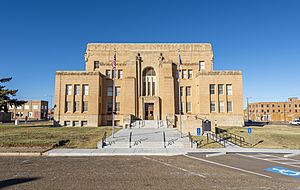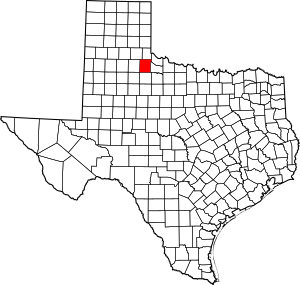Cottle County, Texas facts for kids
Quick facts for kids
Cottle County
|
|
|---|---|

Cottle County Courthouse in Paducah
|
|

Location within the U.S. state of Texas
|
|
 Texas's location within the U.S. |
|
| Country | |
| State | |
| Founded | 1892 |
| Named for | George Washington Cottle |
| Seat | Paducah |
| Largest town | Paducah |
| Area | |
| • Total | 902 sq mi (2,340 km2) |
| • Land | 901 sq mi (2,330 km2) |
| • Water | 1.1 sq mi (3 km2) 0.1% |
| Population
(2020)
|
|
| • Total | 1,380 |
| • Density | 1.530/sq mi (0.5907/km2) |
| Time zone | UTC−6 (Central) |
| • Summer (DST) | UTC−5 (CDT) |
| Congressional district | 13th |
Cottle County is a place in the state of Texas in the United States. In 2020, about 1,380 people lived there. The main town and county seat is Paducah.
Cottle County was started in 1876 and officially set up in 1892. It is named after George Washington Cottle. He was a brave person who died while defending the Alamo. For a long time, Cottle County did not allow the sale of alcohol. Now, it does allow the sale of beer and wine.
A very large farm called the Matador Ranch used to reach into Cottle County. This ranch was based in a nearby county called Motley County.
Contents
Exploring Cottle County's Geography
Cottle County covers a total area of about 902 square miles. Most of this area, about 901 square miles, is land. Only a small part, about 1.1 square miles, is covered by water.
Main Roads in Cottle County
These are the most important roads that go through Cottle County:
 U.S. Highway 62
U.S. Highway 62 U.S. Highway 70
U.S. Highway 70 U.S. Highway 83
U.S. Highway 83
Counties Next to Cottle County
Cottle County shares its borders with several other counties:
- Childress County (to the north)
- Hardeman County (to the northeast)
- Foard County (to the east)
- King County (to the south)
- Dickens County (to the southwest)
- Motley County (to the west)
- Hall County (to the northwest)
Understanding Cottle County's Population
The number of people living in Cottle County has changed over time. Here is a look at the population from different years:
| Historical population | |||
|---|---|---|---|
| Census | Pop. | %± | |
| 1880 | 24 | — | |
| 1890 | 240 | 900.0% | |
| 1900 | 1,002 | 317.5% | |
| 1910 | 4,396 | 338.7% | |
| 1920 | 6,901 | 57.0% | |
| 1930 | 9,395 | 36.1% | |
| 1940 | 7,079 | −24.7% | |
| 1950 | 6,099 | −13.8% | |
| 1960 | 4,207 | −31.0% | |
| 1970 | 3,204 | −23.8% | |
| 1980 | 2,947 | −8.0% | |
| 1990 | 2,247 | −23.8% | |
| 2000 | 1,904 | −15.3% | |
| 2010 | 1,505 | −21.0% | |
| 2020 | 1,380 | −8.3% | |
| U.S. Decennial Census 1850–2010 2010 2020 |
|||
In 2000, there were 1,904 people living in Cottle County. There were 820 households, which are groups of people living together. About 550 of these were families. The county had about 2 people per square mile.
Many types of people live in Cottle County. In 2000, most people were White. There were also many African American and Hispanic or Latino residents.
About 28% of households had children under 18 years old. More than half of the households were married couples. About 32% of all households were single people living alone. Many of these were people aged 65 or older. The average household had about 2.28 people.
The median age in the county was 44 years old. This means half the people were older than 44 and half were younger. For every 100 females, there were about 87 males.
The median income for a household was about $25,446 per year. For families, it was about $33,036 per year. The average income per person was around $16,212.
Towns and Communities in Cottle County
Cottle County has one main town and several smaller communities.
Main Town
- Paducah (This is the county seat, where the main government offices are.)
Smaller Communities
These places are not officially towns but are communities where people live:
- Cee Vee
- Chalk
- Delwin
- Dunlap
- Hackberry
Old or "Ghost" Towns
These are places where people used to live, but now they are mostly empty or no longer exist:
- Ginsite
- Narcisso
- Ogden
- Sneedville
- Swearingen
Learning and Schools
Students in Cottle County attend schools in different school districts. These districts help provide education for children and teens.
- Childress Independent School District
- Paducah Independent School District
- Quanah Independent School District
For older students, Cottle County is also part of the area served by Vernon College. This college offers higher education opportunities.
See also
 In Spanish: Condado de Cottle para niños
In Spanish: Condado de Cottle para niños

